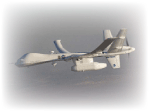NOAA Announces Investment in Unmanned Aircraft Systems Testing
January 24, 2008
 NASA Altair Unmanned Aircraft System (UAS) during NASA Fire Mission of 2006 |
On January 22, 2008, at the annual meeting of the American Meteorological Society in New Orleans, NOAA announced that it has invested $3 million towards testing of Unmanned Aircraft Systems (UAS). Unmanned aircraft can allow for safe high-quality measurements on research flights that are too dangerous or too long for pilots and scientists. Marty Ralph, of the NOAA Earth System Research Laboratories, Physical Sciences Laboratory, is the Project Manager of the NOAA UAS program.
Working with university and industry partners, NOAA will will take instrumentation on three test projects of unmanned aircraft from Summer 2008 – Spring 2009: Atlantic and Gulf Hurricanes, Arctic Climate Change, and Pacific and West Coast Storms.
Research utilizing UAS provides many potential benefits to society including:
- improved hurricane landfall lead times;
- better determination of the extent of hurricane evacuations needed;
- improved understanding of climate to better plan for any future changes;
- development of precipitation forecasting to manage water resources and predict flooding;
- assessment of Arctic ice change and its impacts on ecosystems, coasts, and transportation;
- increased safety and effectiveness in fighting fires to protect people and property;
- broadened abilities to monitor and enforce fishing regulations;
- better protection of marine sanctuaries and national monuments, endangered species and other natural treasures; and
- increased accuracy of coastline mapping and monitoring.
UAS measurements can strongly support and complement ongoing NOAA field programs and satellite observations by providing continuous targeted sampling over long durations not possible with satellites or manned aircraft.
| Contact: Marty Ralph | More Information: |